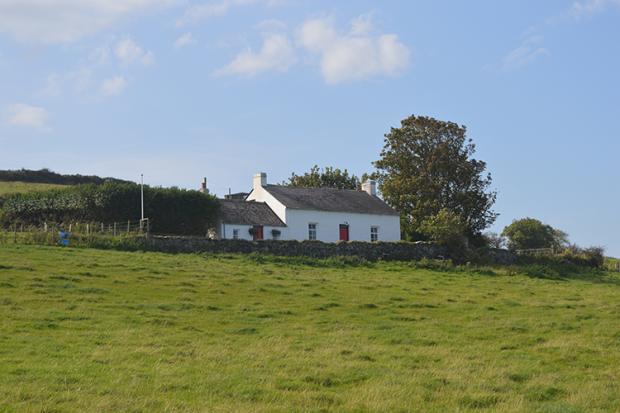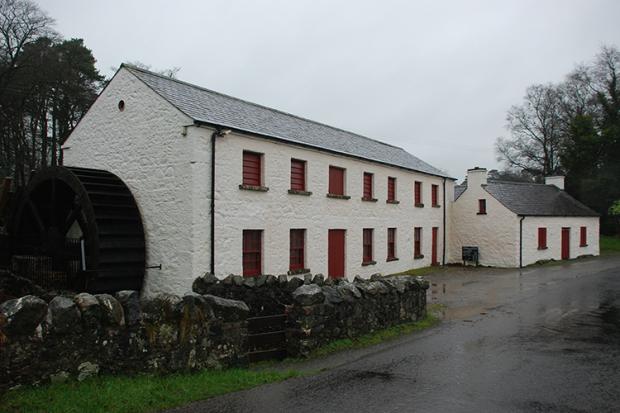Traditional or Vernacular buildings
Most vernacular buildings in Northern Ireland are small, simple, single or two storey structures, constructed without formal design, using local materials. These historic buildings are often known as ‘cottages’ or are said to be of ‘traditional’ construction.
Why are vernacular buildings important?

They are important because they provide information about our ancestors and their local traditions, skills, customs and ‘way of life’. They provide a tangible link to our past and our historical interaction with the land and its materials, demonstrating a record of traditional construction techniques and craft skills.
Most are small, simple, single or two storey structures, constructed without formal design, using local materials. Many will have evolved from small buildings, typically extending in line with the original building or with raised walls to create upper levels. The majority of surviving examples in Northern Ireland, date from the eighteenth and nineteenth centuries, although older examples are also known. Earlier structures are very rare even as archaeological remains
Rural vernacular buildings are also important for their contribution to the local landscape character of a place and its local distinctiveness, through their layout, appearance, and influence on the evolution of the surrounding landscape.
Definition
The Department carried out a statistical survey of these buildings in 1998 and as part of this agreed the following definition of ‘rural’ vernacular buildings with stakeholders:
“Rural vernacular or traditional architecture is the construction of small plain buildings in the countryside (particularly before 1925) where the dominant influence in siting materials, form and design is the local ‘folk tradition’. Such vernacular buildings will have been typical, i.e, of a common type in any given locality and will lack individualistic and ‘educated’ design features that characterised international fashions in formal architecture during the same period.”

While commonly identified as rural dwellings, vernacular building examples also include mill buildings, schools, churches, halls, farmsteads, outbuildings, and other associated structures. Examples of vernacular heritage can also be found in settlements.
Advice and further Information
A good detailed ‘home owners handbook’ which explains the history of these buildings and provides guidance on their sensitive alteration to accommodate modern needs was published by the Mourne Heritage Trust in 2004.
Because of their significance, the department holds records of many of these buildings and many are protected as listed buildings. A small number are also included on the Departments Sites and Monuments Record as features of archaeological or Industrial Heritage interest. A dedicated record is currently being created within the Historic Environment Record of Northern Ireland
Loss of traditional buildings
Over the last 100 years, changing fashions and attitudes have meant that a lot of these buildings have been lost. Listing can only protect buildings of ‘special architectural and historic interest’ i.e the best examples. That leaves the majority dependent upon sympathetic owners for survival.
A way forward

In March 2021 the Department supported Armagh, Banbridge and Craigavon Borough Council through its Historic Environment Fund to develop a seminar ‘Ruins to Riches’ looking at the qualities of these buildings and the issues faced. This was organised by Ulster Architectural Heritage and concluded with presentations by the Department of Housing, Local Government and Heritage on strategic developments in the Republic of Ireland and by DfC seeking to draw the discussion together and set out an agreed way forward.
An overall collective strategy was proposed, discussed and accepted:
Our Aim:
We would like to see our rich vernacular heritage valued by all and the potential it holds fully realised.
To achieve this we work together to ensure:
1. That there is wide public awareness of these buildings and their context – their beauty, history and character- and of the threats they face.
2. That there is information and support available to help people take on such buildings.
3. To encourage planning policies that are supportive of reuse and considerate of the wider vernacular environment.
4. To celebrate success and raise public awareness of the possible
DfC is doing the following in respect of these objectives:
- We are developing a ‘vernacular record’ as part of HERONI to make our information more accessible to all. This is also part of part of DFC’s commitment to archaeology 2030
- We are protecting suitable vernacular structures for listing as part of our ongoing Second Survey of Buildings of architectural or historic interest in Northern Ireland . Information on all buildings considered is published on the Buildings Database
- We are developing a guide for Councils on identifying and valuing vernacular buildings in the planning process.
- We are commenting upon proposed Council planning policies as they are being developed within their Local Development Plans and associated proposals for monitoring their effectiveness in the long term.
- We are commenting upon individual planning applications affecting listed vernacular buildings, and such buildings recorded on the Departments Sites and Monuments Record.
- Given the common issues faced we have supported the momentum of the DHLGH three year policy and worked with colleagues in the Republic to:
- Develop guidance for owners on how to care for these buildings, on how to take on these buildings and reuse them and on how they can be improved to minimise climate change impact.
- Update our knowledge of what is out there, and the risks faced, and consider if there are particular issues along the border area.
- Subject to available funding we will also:
- Continue to support communities through the Historic Environment Fund to explore and discuss the issues - as we did for the 2019 Lough Neagh Landscape Partnership seminar ‘It was someone’s home': A Rural Vernacular Conference and in 2023 for the Lough Erne Landscape Partnership’ (The impact of the Historic Environment Fund Research Stream) and in 2024 to Armagh, Banbridge and Craigavon District Council Saturday 3 February 2024: Understanding the Repair and Maintenance of Traditional Buildings Workshop - Lurgan Townscape Heritage
- Continue to provide support to owners through the Historic Environment Fund for repairs to listed buildings, with a priority afforded to maintaining thatched roofs.
- Continue to work with owners to open their doors and share their experience as part of European Heritage Open Days (EHOD) every September.
How can I contribute?
- Could you – join the discussion and respond to public consultations on Local Development Plans including vernacular planning policies as these are developed for your area?
- If you are an owner could you share information with us and others on what you did and what the hurdles you faced were? Or on what is preventing you from taking the plunge?
- If you are a heritage organisation or area partnership could you research and publish on your area or hold events to celebrate it? Could you contribute to EHOD?
- If you are a group interested in a particular building, could you form a building preservation trust and make a difference?
What are others doing?
Lough Erne Landscape Partnership and Queens University have developed training on studying vernacular buildings.
SPAB Ireland often arrange a series of events and seminars on the subject. They also have their own Podcast Heart to Hearth Podcast.
UAH, have developed a Hands on Heritage project that includes information on vernacular buildings and their recording. Their aim is to ‘provide a programme that combines traditional heritage engagement and outreach with the introduction of a range of new digital engagement technologies, to better connect people and communities with built heritage.’
Useful links:
- ICOMOS Charter on the Built Vernacular Heritage (1999)
- Building on Tradition - A sustainable Design Guide for the Northern Ireland Countryside
- Traditional buildings on Irish farms
- Traditional Buildings in Ireland a Home Owners Handbook, Mourne Heritage Trust, 2004
- Caring for our Vernacular Heritage, DfC & DHLGH, 2022
- Sources of Information for Built Vernacular Heritage
